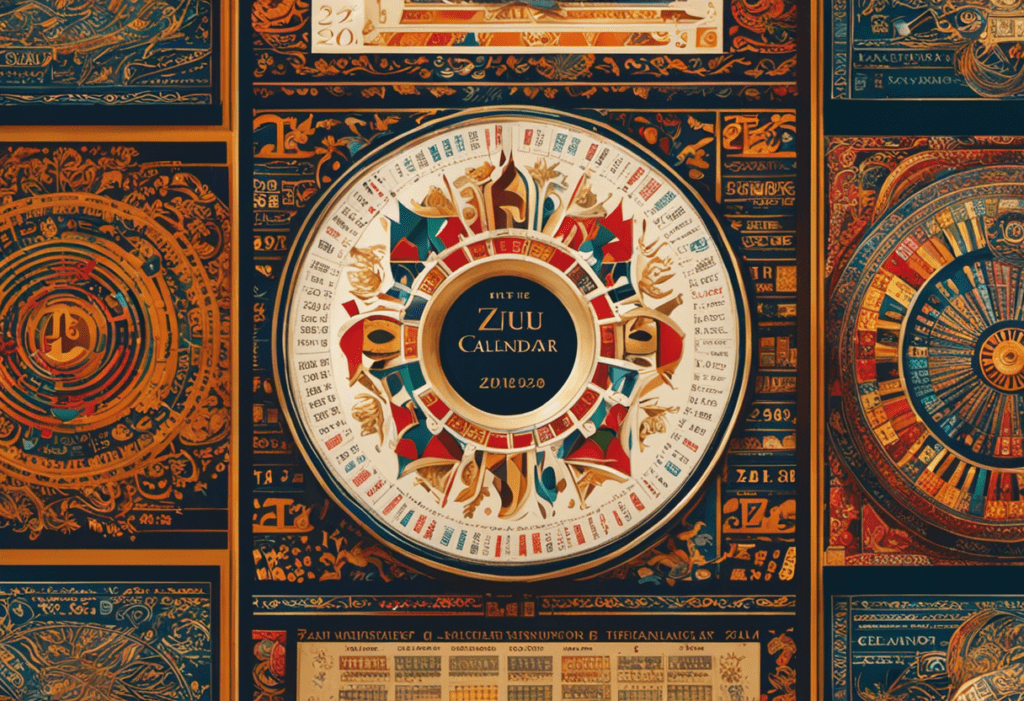The symbols and iconography of the Zulu calendar hold immense cultural and historical significance. This article delves into the intriguing world of Zulu symbolism, exploring the role of the sun and moon, animal representations, and plant iconography.
Additionally, it examines the symbols that reflect tribal heritage and identity, as well as those associated with ritualistic practices and ceremonies.
By delving into the cultural meaning of colors, we gain a deeper understanding of the rich traditions preserved in the Zulu calendar.
Key Takeaways
- The sun represents life, light, and vitality, while the moon is associated with femininity, fertility, and growth in Zulu culture.
- Animal symbols in the Zulu calendar carry deep cultural meaning and symbolism, representing specific qualities such as strength, courage, wisdom, and family.
- Symbol usage in the Zulu calendar has evolved over time, initially representing seasons and weather patterns, and later gaining more complex meanings related to values, social roles, and ideologies.
- Plant and nature symbols in the Zulu calendar hold cultural and spiritual meaning, representing changing seasons, indigenous plant knowledge, and emphasizing environmental conservation and cultural identity.
The Significance of the Sun and Moon
During the study of the Zulu calendar, it is crucial to explore the significance of the sun and moon within their cultural beliefs and practices. The Zulu people have a deep reverence for celestial bodies, considering them to be powerful entities that influence various aspects of their lives.
The sun, known as ‘uLanga’ in Zulu, represents life, light, and warmth. It symbolizes vitality and energy, and its daily journey across the sky is seen as a metaphor for the cycle of life.
The moon, called ‘iLanga’ in Zulu, holds a special place in Zulu rituals and ceremonies. It is associated with femininity, fertility, and the cycles of nature. The waxing and waning of the moon are seen as representations of growth and transformation.
The Zulu people incorporate astronomical symbolism in their rituals and ceremonies. For example, the new moon is often associated with new beginnings and is an auspicious time for important events such as weddings or initiations. The full moon, on the other hand, is believed to have a powerful energy that enhances the effectiveness of healing and divination practices.
The significance of the sun and moon in the Zulu calendar reflects the deep connection that the Zulu people have with the natural world and their belief in the interconnectedness of all things.
Animal Symbols in the Zulu Calendar
Animal symbols play a significant role in the Zulu calendar, carrying deep cultural meaning and symbolism.
These symbols are not arbitrary but have been carefully chosen to represent specific qualities and characteristics associated with each animal.
The usage of animal symbols has evolved over time, reflecting the changing cultural and societal dynamics within the Zulu community.
Meaning of Animal Symbols
The interpretation and significance of animal symbols play a pivotal role in the Zulu Calendar. Animals hold deep cultural symbolism and spiritual significance within Zulu traditions and beliefs. Each animal symbolizes different qualities, characteristics, and attributes that are associated with specific months or seasons in the calendar.
For example, the lion represents strength, courage, and leadership, and is often associated with the month of April. The elephant symbolizes wisdom, power, and family, and is linked to the month of June.
The meaning of animal symbols in the Zulu Calendar goes beyond mere representation; it embodies the essence of the natural world and its interconnectedness with human life. These symbols serve as a reminder of the importance of harmony and balance between humans and nature, as well as the respect and reverence for the animal kingdom.
Cultural Significance of Symbols
How do the animal symbols in the Zulu Calendar hold cultural significance?
The animal symbols in the Zulu Calendar are rich in symbolic meanings and serve as important cultural expressions within the Zulu community.
Each animal depicted in the calendar represents specific qualities or attributes that hold significance in Zulu culture. For example, the lion symbolizes bravery and leadership, reflecting the ideals of strength and courage valued by the Zulu people.
The elephant, on the other hand, represents wisdom and longevity, symbolizing the importance of ancestral knowledge and the continuity of traditions.
These animal symbols not only convey important cultural values but also serve as reminders of the interconnectedness between humans and nature, emphasizing the Zulu people’s close relationship with the natural world.
Evolution of Symbol Usage
Over time, as the Zulu calendar has evolved, there has been a gradual shift in the usage and interpretation of animal symbols. These symbols have played a significant role in the cultural meaning of the Zulu calendar, representing various aspects of life and spirituality.
- Animal symbols were initially used to represent different seasons and weather patterns. For example, the lion symbolized the dry season, while the buffalo represented the rainy season.
- As the Zulu people’s understanding of the natural world deepened, animal symbols began to take on more complex meanings. They started to represent qualities such as strength, wisdom, and bravery.
- Today, animal symbols in the Zulu calendar continue to evolve, reflecting the changing cultural landscape. They are now used to represent values, social roles, and even political ideologies.
The evolution of symbol usage in the Zulu calendar demonstrates the dynamic nature of cultural symbolism and its ability to adapt to the changing needs and beliefs of a society.
Plant and Nature Iconography
Within the realm of Zulu calendar symbolism, plant and nature iconography holds significant cultural and spiritual meaning. Environmental conservation in Zulu culture is deeply intertwined with the understanding and appreciation of the natural world. The Zulu people have a rich indigenous plant knowledge that is not only utilized for medicinal and culinary purposes but also plays a crucial role in the representation of the calendar.
The Zulu calendar incorporates various plant and nature symbols to depict different times of the year and important cultural events. The changing seasons are often represented through the blooming of specific flowers or the ripening of certain fruits. For example, the flowering of the amaryllis plant signifies the arrival of spring, while the ripening of the marula fruit represents the beginning of the harvest season.
Furthermore, indigenous plant knowledge is passed down through generations, and this knowledge is reflected in the symbols used in the Zulu calendar. Each plant carries its own symbolic meaning, representing different aspects of life, fertility, or spiritual beliefs. The incorporation of these plant symbols in the calendar not only serves as a reminder of the importance of environmental conservation but also strengthens the cultural identity and spiritual connection of the Zulu people to their natural surroundings.
Symbols of Tribal Heritage and Identity
Symbols play a significant role in the preservation of Zulu traditions and the expression of tribal heritage and identity. These symbols hold cultural significance and serve as visual representations of historical narratives, beliefs, and values.
Through the use of symbols, the Zulu people are able to transmit their cultural heritage to future generations and maintain a sense of collective identity.
Cultural Significance of Symbols
The cultural significance of symbols in the Zulu calendar lies in their ability to preserve and transmit the rich heritage and identity of the tribe. Symbols play a crucial role in storytelling, allowing the Zulu people to pass down their traditions, beliefs, and values from generation to generation.
These symbols are deeply ingrained in the cultural fabric of everyday life, serving as a constant reminder of their ancestral roots and collective identity. They serve as a visual language, communicating complex ideas and concepts that are central to the Zulu way of life. From the intricate patterns and motifs on traditional clothing to the symbolic meanings behind certain colors and animals, symbols in the Zulu calendar act as a powerful tool for cultural expression, fostering a sense of unity and pride among the tribe.
Role in Preserving Traditions
How do symbols in the Zulu calendar contribute to the preservation of tribal traditions and the maintenance of tribal heritage and identity?
The symbols in the Zulu calendar play a crucial role in educating future generations about their cultural heritage. The calendar serves as a visual representation of important events, rituals, and beliefs that have been passed down through generations.
Through the symbols depicted in the calendar, the Zulu people are able to teach their children about their history, customs, and values. Additionally, these symbols have also influenced contemporary art, as artists incorporate them into their work to celebrate and honor the Zulu culture.
Rituals and Ceremonies Depicted in the Calendar
Various cultural practices and sacred observances are represented through the rituals and ceremonies depicted in the Zulu calendar. This calendar serves as a visual representation of the rich cultural heritage of the Zulu people, providing insights into their traditional customs and beliefs.
The rituals and ceremonies depicted in the Zulu calendar are characterized by their cultural symbolism and significance. They play a crucial role in maintaining social cohesion and reinforcing the values and traditions of the Zulu community. Here are three examples of such rituals and ceremonies:
- The Reed Dance: This annual ceremony is a celebration of young Zulu maidens’ purity and virginity. It involves a procession where young girls present reeds to the Zulu king, symbolizing their chastity. The Reed Dance is an important cultural event that showcases the Zulu community’s commitment to preserving traditional values.
- Ukweshwama Festival: This harvest festival is held annually to honor the ancestral spirits and give thanks for a bountiful harvest. It involves rituals and ceremonies that invoke the blessings of the ancestors and ensure the fertility of the land. The Ukweshwama Festival is a vital cultural practice that reinforces the Zulu people’s connection to their land and ancestors.
- Ancestral Worship: The Zulu calendar also depicts various rituals and ceremonies dedicated to ancestral worship. These practices involve offerings, prayers, and rituals aimed at honoring and seeking guidance from the ancestors. Ancestral worship is deeply rooted in Zulu culture and is considered essential for maintaining a harmonious relationship between the living and the departed.
Exploring the Cultural Meaning of Colors in the Zulu Calendar
Colors and their cultural meanings play a significant role in the Zulu calendar, reflecting the traditions and symbolism of the Zulu people. Exploring symbolism in Zulu art reveals a deep connection between color and cultural beliefs. The Zulu people attribute specific meanings to different colors, which are then incorporated into their calendar.
Red, for example, holds great significance in Zulu culture. It symbolizes blood, strength, and power. This color is often associated with warriors and is used to represent courage and bravery. In the Zulu calendar, red may be used to depict important events or ceremonies related to warfare or leadership.
White, on the other hand, represents purity and spirituality. It is often used to symbolize important religious ceremonies or rituals. In the Zulu calendar, white may be used to depict significant religious holidays or observances.
Black, a color often associated with mourning in many cultures, also holds a similar meaning in Zulu culture. It represents death, grief, and sadness. In the Zulu calendar, black may be used to depict times of mourning or remembrance.
Conclusion
The symbols and iconography of the Zulu calendar hold deep cultural meaning and significance. Through the depiction of the sun and moon, animal symbols, plant and nature iconography, tribal heritage, and rituals and ceremonies, the calendar serves as a representation of the Zulu people’s identity and traditions.
The use of colors further enriches the calendar, reflecting the cultural diversity and vibrancy of the Zulu community.
Overall, the Zulu calendar is a powerful and intricate reflection of their rich cultural heritage.



